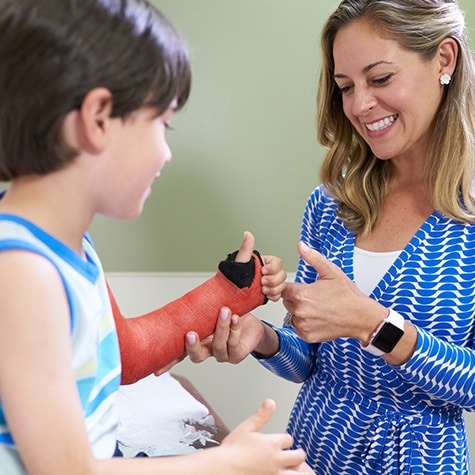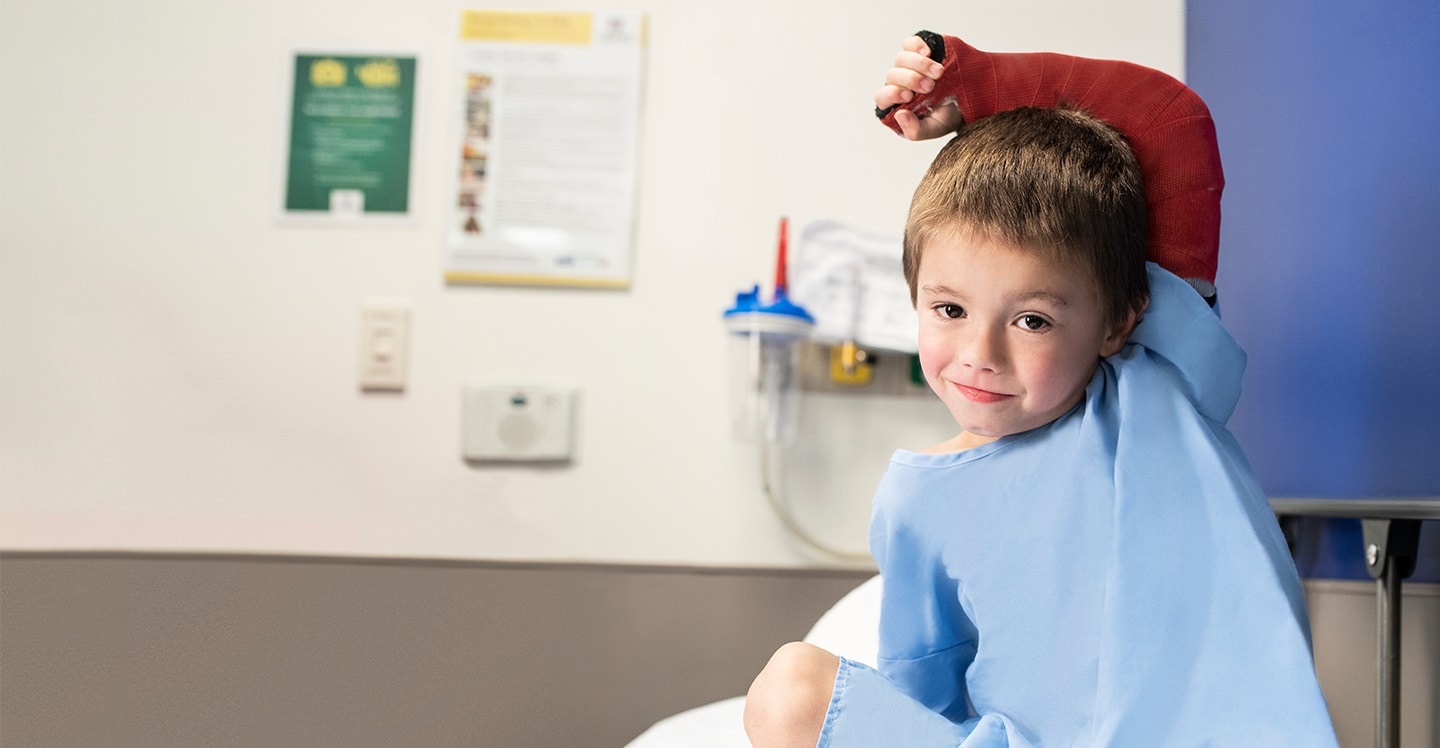Kids are kids. Playtime, sports activities and just plain running around can sometimes lead to broken bones or bone fractures. If you suspect your child has a broken bone, it’s important to get care quickly so that her bones can heal properly. But where should you go first—urgent care or the emergency department?
The good news: Children’s Healthcare of Atlanta has both. And all locations are staffed by specialists trained to treat fractures in growing bones. Here are some tips on choosing which type of care is best for your child after an injury.
Emergency Department or Urgent Care?
You should consider taking your child to the Emergency Department if any of the following are true:
- The bone has pierced through the skin (call 911 if the injury is severe or is bleeding heavily).
- Your child feels numbness or tingling in the broken or injured area.
- The area appears crooked and misshapen.
- You cannot control your child’s pain.
A visit to one of our eight Urgent Care Centers may be the best option for your child if:
- The injury occurs in a smaller bone, such as in the hands, feet, wrist or ankle.
- There is bruising and swelling at the site of the injury.
- Your child can’t move the area or press on it without pain.
Depending on how severe your child’s fracture is, the specialists at our Urgent Care Centers may transfer you and your child to the nearest Children’s Emergency Department.
Make an appointment with an orthopedic specialist
Children’s bones heal quickly, so it’s important to seek treatment right away to ensure bones are in the right place and heal correctly. Once you've visited the Emergency Department or an Urgent Care Center, visit a pediatric orthopedic specialist or pediatric hand specialist approximately five to seven days after the injury. Bring any X-rays you may have on a CD to your child's appointment.
If you believe your child's injury is minor, Children's pediatric orthopedic specialists offer same-day fracture care appointments. They can perform X-rays and provide appropriate treatment on site if your child needs a cast or a splint. If your child’s injury is not severe, make an appointment online or contact us at 404-255-1933 to schedule a fracture care visit.
Notify your pediatrician
Any time your child experiences a possible bone fracture, contact your child’s pediatrician to inform them of the injury. They can help guide you on where it’s best to seek care and how to manage symptoms at home until you can see a specialist.

Our orthopedic doctors know how to treat fractures.
We know how to properly set growing bones in kids and teens. If your child doesn’t need immediate medical attention, Children’s Physician Group–Orthopaedics and Sports Medicine can often accommodate your child for a same-day appointment.
Contact UsPediatric Fracture Care Is Important
We specialize in pediatric fracture care for infants, children, adolescents and young athletes. Our team uses X-rays to help diagnose fractures. While not all breaks are easy to spot, our board-certified pediatric radiologists are trained to quickly and accurately diagnose injured bones.
Is it a bone fracture or a break?
If your child is injured, the first priority is to determine—through the use of X-rays—whether a bone is fractured. A fracture is a clinical term for a break in the bone. (In other words, a broken bone and a bone fracture are the same thing.) Next, doctors will determine what type of fracture it is.
Your child may have one of two types of fractures:
- Displaced—A fracture is displaced if pieces of the bone bend or move out of proper position.
- Nondisplaced—A fracture is nondisplaced if the bones stay in place.
Why didn't my child's broken bone show up on the X-ray?
Not every fracture shows up on an X-ray. Children, in particular, can have broken bones and still have normal X-rays that do not reveal an obvious fracture. It is hard to see a fracture if it occurs on the bone’s growth plate, especially if it is a nondisplaced fracture (bones that stay in place). Since fractures can be hard to see at first, the doctor may tell you that your child’s X-ray looks normal, but will treat your child in case the fracture shows up on an X-ray later.
As a fracture heals, your child’s body sends extra calcium, bone cells and blood vessels to rebuild the bone. After seven to 10 days of rebuilding, there will be enough calcium around the fracture so that it shows up on an X-ray. This is why one doctor may conclude that your child does not have a fracture, but another doctor may diagnose a fracture later on.

Radiology for children requires specialized knowledge.
There is more cartilage in kids’ growing bones, which can make a child’s X-ray look incomplete. It’s important to see board-certified pediatric radiologists and pediatric orthopedic providers who specialize in recognizing and treating broken bones in growing kids and teens.
LEARN MOREIt’s important to seek early treatment for all fractures. Children’s bones heal quickly and may not be in the correct place. Visit a pediatric orthopedic specialist or pediatric hand specialist no more than five to seven days after the injury. If you have X-rays on a CD taken during your visit to an Urgent Care Center or Emergency Department, bring them to your child's appointment.
Your child’s care team will create a treatment plan tailored to her needs. This treatment plan will depend on:
- The type of fracture
- Your child’s age and health
- Whether there are any other injuries
Why is setting a broken bone important?
“Setting” a broken bone means taking a crooked, displaced fracture and moving it back into place to allow it to heal. This is called a reduction. Your child’s orthopedic specialist will discuss reduction options with you and help identify the best treatment for your child.
There are two reduction methods that your orthopedic specialist may recommend to set the bone and allow it to heal correctly:
- Closed reduction—the broken bone does not require an incision, or surgery, to move it into the right position to heal.
- Open reduction—an incision, or surgery, is needed and the bone will be put in place during an operation.
There are many factors your child’s orthopedic specialist will consider to determine whether an open or closed reduction might be best for your child. However, the goal is always is to allow the broken area around the fracture to eventually look normal and function as normally as possible.
Ways to prevent the bone from moving once it’s been set may include:
- Applying casts, a brace or splints.
- Inserting hardware like screws, rods, plates or pins into the broken bone during surgery. If there is hardware outside the body, it will be removed when the bone heals.
How long does it take for a bone fracture to heal?
Fractures can take from several weeks to several months to heal, depending on:
- The type of fracture
- Which bone is broken
- How severe the injury is
- The age of the child
Pain usually stops long before the fracture is healed. Your child will be able to begin some activity before the fracture heals completely. Even after removing the cast or splint, your child may need to limit activity until the bone is solid enough to use normally.
If you have concerns about how your child’s injury is healing, call her doctor.
Depending on the type and severity of the fracture, your child’s doctor may recommend physical therapy or occupational therapy after the bone has healed to help regain strength and function.
Locate a Children’s outpatient physical therapy or occupational therapy location near you.
Locate a Children’s sports medicine physical therapy location near you.
Emergency Departments
Egleston Hospital
1405 Clifton Road NE
Atlanta, GA 30322
Hughes Spalding Hospital
35 Jesse Hill Jr. Drive SE
Atlanta, GA 30303
Scottish Rite Hospital
1001 Johnson Ferry Road NE
Atlanta, GA 30342
Urgent Care Centers
Children’s at Chamblee-Brookhaven
5080 Peachtree Blvd., Suite 100
Chamblee, GA 30341
Children’s at Cherokee
1558 Riverstone Parkway, Suite 100
Canton, GA 30114
Children’s at Forsyth
The Collection at Forsyth
410 Peachtree Parkway
Cumming, GA 30041
Children’s at Hamilton Creek
2240 Hamilton Creek Parkway, Suite 600
Dacula, GA 30019
Children’s at Hudson Bridge
1510 Hudson Bridge Road
Stockbridge, GA 30281
Children’s at North Point
3795 Mansell Road
Alpharetta, GA 30022
Children’s at Satellite Boulevard
2660 Satellite Blvd.
Duluth, GA 30096
Children’s at Town Center
625 Big Shanty Road NW
Kennesaw, GA 30144
This content is general information and is not specific medical advice. Always consult with a doctor or healthcare provider if you have any questions or concerns about the health of a child. In case of an urgent concern or emergency, call 911 or go to the nearest emergency department right away. Some physicians and affiliated healthcare professionals on the Children’s Healthcare of Atlanta team are independent providers and are not our employees.
Contact Us 404-785-KIDS (5437)





